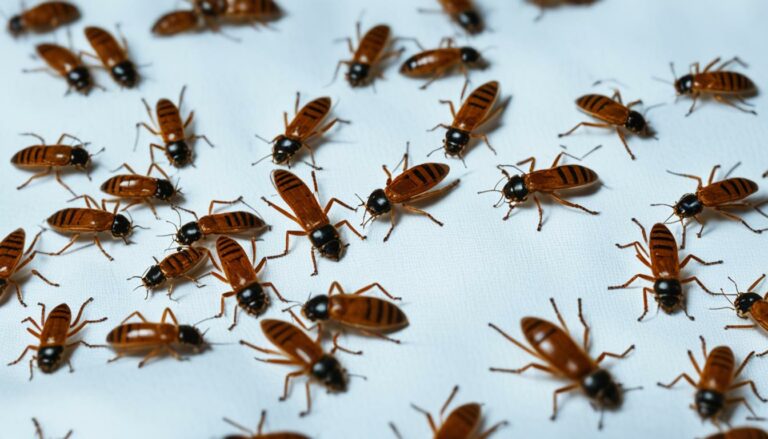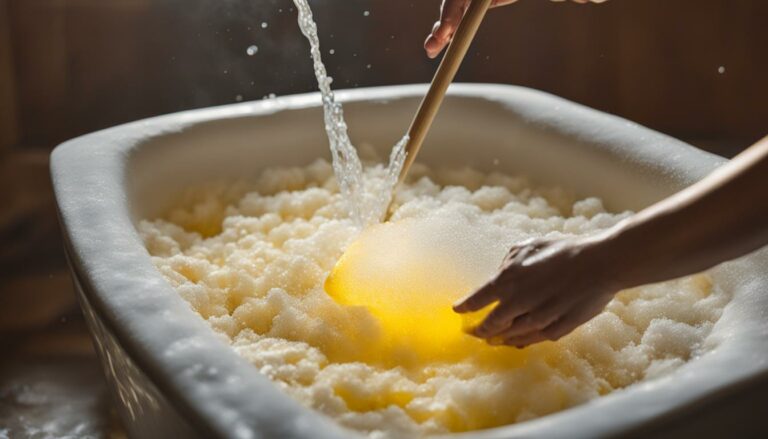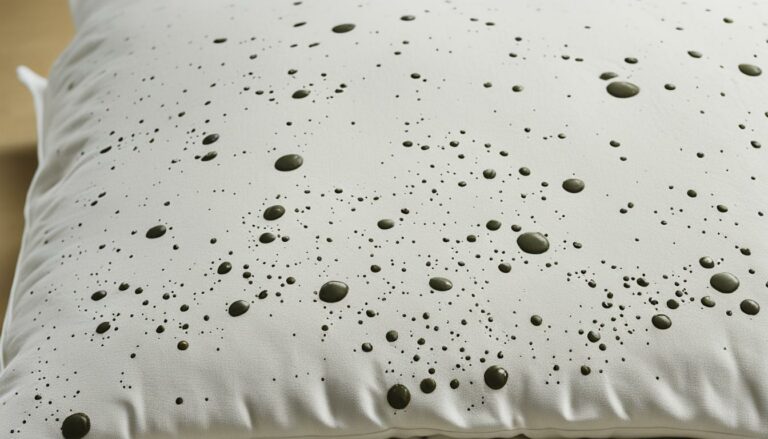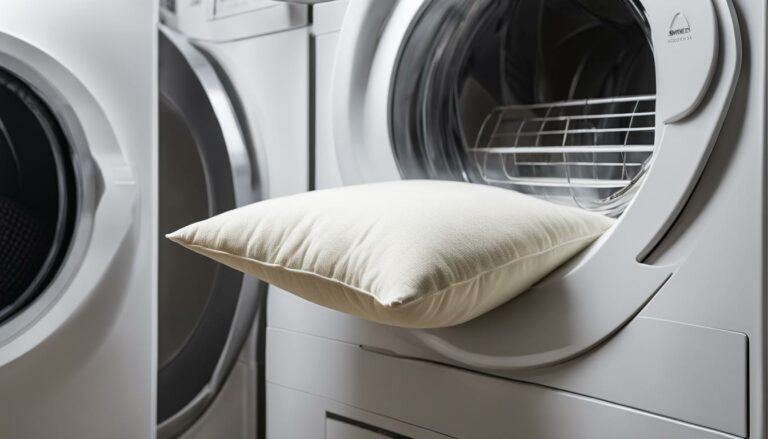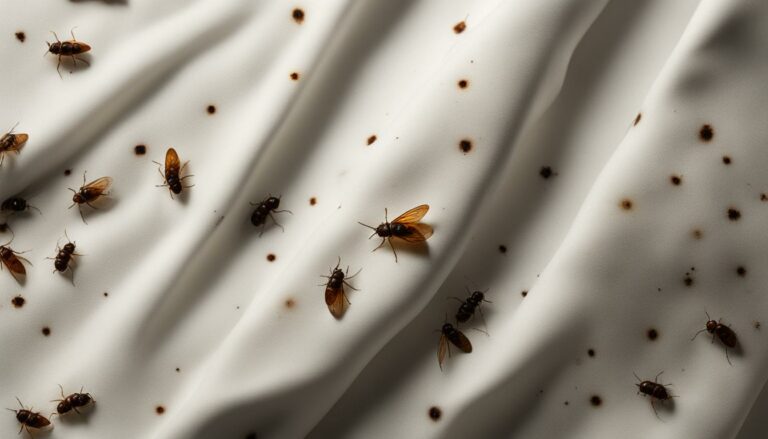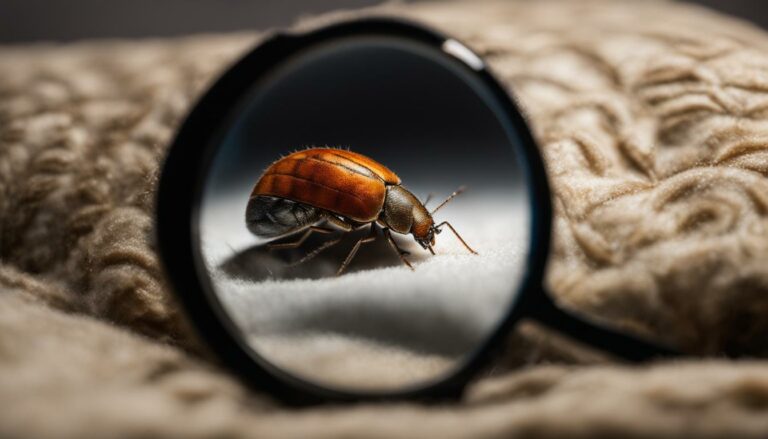Sanitize Easily: Does Putting Pillows in Dryer Kill Germs?
Eric Christie stands as a luminary in the bedding industry, with a career spanning nearly four decades since the early 1980s. His journey through the world of bedding has seen him wear many hats – a manufacturer, designer, and retailer, showcasing his versatility and expertise in Read more...
pillowsandbedsheets.com and its partners may earn a commission if you purchase a product through one of our links
Pillows are your trusty companions throughout the night, providing comfort and support for a good rest. But did you know that they can also harbor germs? Over time, pillows can accumulate dirt, dust, sweat, saliva, bacteria, and even mold or mildew. These unwanted guests can lead to unpleasant odors and a decline in pillow support. To keep your pillows fresh and germ-free, regular cleaning is essential.
One popular method for sanitizing pillows is by putting them in the dryer. But the question remains: does it actually kill germs? In this article, we’ll explore the answer to this question and provide you with some valuable pillow care tips for effective germ elimination.
Key Takeaways:
- Regular pillow cleaning is crucial to maintain good hygiene and eliminate germs that may be present.
- Washing pillows in a washing machine can effectively remove dirt and bacteria.
- Drying pillows in the dryer can help eliminate moisture and prevent the growth of bacteria and mold.
- Alternative drying methods, such as air-drying and sun-drying, can also aid in disinfecting pillows.
- Specific care should be taken based on the type of pillow filling to maintain its quality and cleanliness.
The Importance of Pillow Cleaning
Pillows are an essential item used daily, but did you know that they can harbor germs? Due to their constant contact with the face and respiratory system, pillows can accumulate germs including bacteria, fungi, and viruses. These germs can accumulate on pillow covers and seep into the filling material, leading to unpleasant odors and potential health risks.
Regular pillow cleaning is crucial to maintain good hygiene and eliminate germs that may be present. By following proper cleaning techniques, you can ensure that your pillows remain fresh, hygienic, and supportive for a good night’s sleep.
Germs can thrive in warm and cozy environments, making your pillow a prime spot for their accumulation. Furthermore, sweat, saliva, and other bodily fluids can also contribute to the growth of bacteria and the development of unpleasant odors. By cleaning your pillows regularly, you can remove these sources of germ accumulation, ensuring a cleaner and healthier sleep surface.
“A clean pillow is not only important for your overall hygiene, but it also plays a vital role in maintaining the pillow’s support and longevity.”
Regular pillow cleaning can help extend the lifespan of your pillows while providing you with optimal support and comfort. It’s worth noting that proper cleaning techniques vary depending on the type of pillow filling. For example, the care and cleaning of down feather pillows differ from those of polyester or memory foam pillows.
To better understand the importance of pillow cleaning and how it can help maintain hygiene and support, let’s dive into the various factors associated with pillow cleaning:
Germ Accumulation in Pillows
Pillows come into close contact with our bodies, capturing sweat, oil, dead skin cells, and other debris. Over time, these materials create an environment where germs thrive. The accumulation of germs in pillows can not only cause unpleasant odors but also pose potential health risks. Regular cleaning is crucial to remove these harmful germs from our sleep environment.
Pillow Odor
Do you notice an unpleasant odor coming from your pillows? It’s likely due to the accumulation of germs, sweat, and other bodily fluids. Regular pillow cleaning is essential to eliminate these odors, leaving your pillows smelling fresh and clean.
Pillow Support
Proper pillow support is crucial for a good night’s sleep and spinal alignment. Over time, the accumulation of dirt, oils, and germs can cause the pillow filling to become lumpy and lose its supportive qualities. By regularly cleaning your pillows, you can maintain their support and ensure a comfortable sleep surface.
Now that we understand the importance of pillow cleaning, let’s explore how to properly wash and care for your pillows in the next section.
How to Wash Pillows
Washing pillows is a simple process that can be done in a washing machine. Follow these steps to ensure your pillows are fresh and clean:
- Before washing, remove any covers or pillowcases and check the manufacturer’s instructions. This will help you determine the appropriate cleaning method for your pillows.
- Most down and synthetic pillows can be machine-washed on low heat. This setting helps protect the pillow filling and maintain its quality.
- Use a fragrance-free laundry detergent to avoid any potential irritation. Follow the recommended amount of detergent for pillow washing.
- Spot-clean any stains on the pillows before running the wash cycle. This will help ensure better cleaning results.
When washing your pillows, it’s important to prioritize thorough drying to prevent the growth of bacteria and mold. Consider the following:
- Choose a gentle drying setting on your machine to minimize any potential damage to the pillows.
- Ensure the pillows are thoroughly dried before removing them from the dryer. Moisture trapped inside can lead to unpleasant odors and mildew growth.
Remember, proper washing and drying will help keep your pillows clean, fresh, and germ-free.
Follow these simple steps to wash your pillows and keep them clean and fresh.
Drying Pillows in the Dryer
Putting pillows in the dryer can effectively dry them and remove moisture, which helps prevent the growth of bacteria, mold, and mildew. It’s a convenient and efficient method for maintaining pillow hygiene. Here are some important tips to follow when drying pillows in the dryer:
- Use a low heat setting: Set your dryer to a low heat or delicate cycle to protect the pillow filling and prevent any damage. High heat can cause the filling to clump or lose its shape.
- Check the pillows regularly: Every 20 to 30 minutes, pause the drying cycle to check the pillows. Fluff them up and ensure even drying. This will help prevent any areas from remaining damp or taking longer to dry.
- Add dryer balls or a tennis ball: To aid in fluffing the pillows and keeping them nice and comfortable, consider adding dryer balls or a tennis ball inside a sock. These objects provide extra agitation, helping to maintain the pillow’s shape.
Complete drying is crucial to eliminate any remaining moisture and maintain optimal pillow hygiene. Be sure to follow these guidelines to ensure that your pillows are thoroughly dry and free from moisture:
“Proper drying is key to prevent the growth of bacteria, mold, and mildew.” – PillowCareExpert
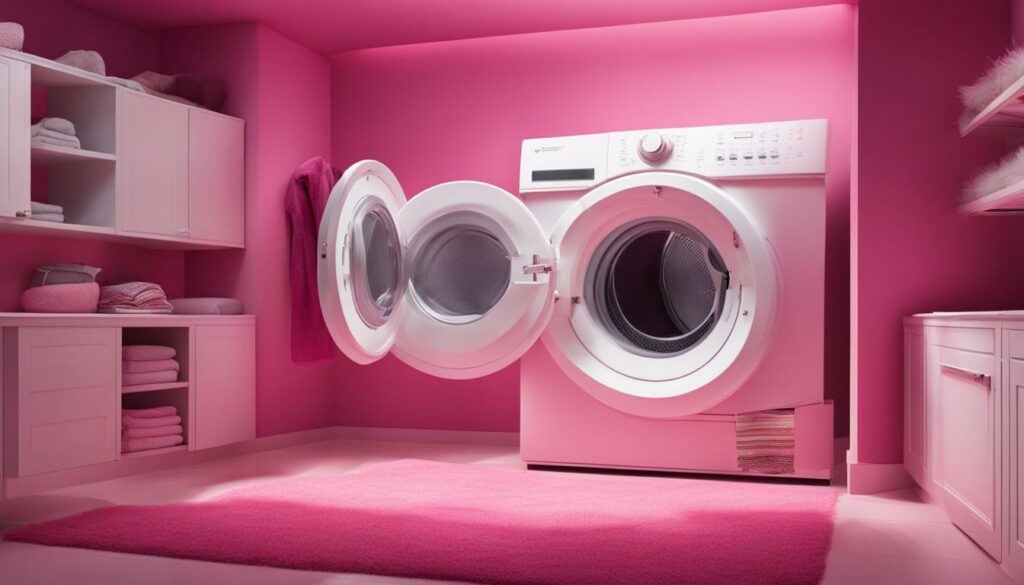
By following these steps, you can successfully dry your pillows and eliminate any moisture that may be lingering. This process helps to preserve the cleanliness and freshness of your pillows, ensuring that they are hygienic and comfortable for use.
Alternative Drying Methods
Besides using a dryer, there are alternative methods to dry and disinfect pillows. Air-drying pillows by hanging them on a clothesline can effectively remove moisture and freshen them. Placing pillows in direct sunlight can act as a natural disinfectant, thanks to the sun’s UV rays. However, it’s important to ensure that the pillows are as flat as possible during sun-drying. This method helps kill bacteria and potential viruses present on the pillow surfaces.
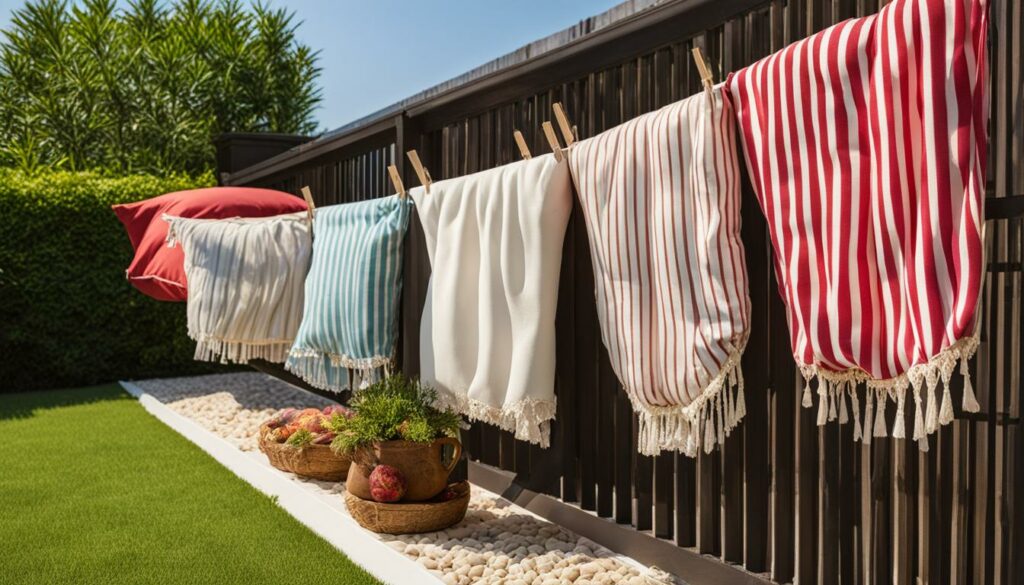
Air-drying and sun-drying pillows offer natural disinfecting benefits while effectively removing moisture. Whether you prefer the convenience of air-drying indoors or harnessing the disinfecting power of the sun, these alternative drying methods can keep your pillows clean and fresh.
Specific Care for Different Pillow Fillings
Proper care and maintenance of pillows are crucial for their longevity and cleanliness. Different pillow fillings require specific care techniques to ensure their quality remains intact. Whether you have down feather pillows, polyester pillows, memory foam pillows, or buckwheat hull pillows, here’s a guide to help you keep them clean and fresh.
Care for Down Feather Pillows
Down feather pillows provide luxurious comfort but require special care to maintain their fluffiness. Here’s how to take care of your down feather pillows:
- Machine-wash with cool water on a gentle cycle
- Use a mild detergent
- Dry the pillows on a no-heat air-dry setting
Care for Polyester Pillows
Polyester pillows are affordable and easy to care for. Here are the steps to keep your polyester pillows clean:
- Machine-wash with warm water on a gentle cycle
- Use less detergent than you would for other fabrics
- Avoid using fabric softeners
- Ensure thorough rinsing to remove all soap residue
Care for Memory Foam Pillows
Memory foam pillows provide excellent support but need special care to prevent damage to the foam. Follow these tips for caring for your memory foam pillows:
- Hand-wash the pillow in warm water with a mild detergent
- Gently squeeze and press to clean
- Rinse thoroughly and squeeze out excess water
- Air-dry in a well-ventilated area
Care for Buckwheat Hull Pillows
Buckwheat hull pillows are unique and require specific care to eliminate odors and keep them clean. Follow these steps to maintain your buckwheat hull pillows:
- Remove the casing and wash it with mild detergent and cold water
- Place the casing in the sun to dry
- Expose the buckwheat hulls to direct sunlight to eliminate odors
Caring for your pillows properly not only ensures their cleanliness but also helps maintain their comfort and support. By following these specific care techniques, you’ll be able to enjoy fresh and cozy pillows for a long time.
| Pillow Filling | Care Instructions |
|---|---|
| Down Feather Pillows | Machine-wash with cool water on a gentle cycle. Dry on a no-heat air-dry setting. |
| Polyester Pillows | Machine-wash with warm water on a gentle cycle using less detergent. Avoid fabric softeners. |
| Memory Foam Pillows | Hand-wash in warm water with a mild detergent. Air-dry in a well-ventilated area. |
| Buckwheat Hull Pillows | Wash the casing with mild detergent and cold water. Sun-dry the casing and expose the buckwheat hulls to sunlight. |
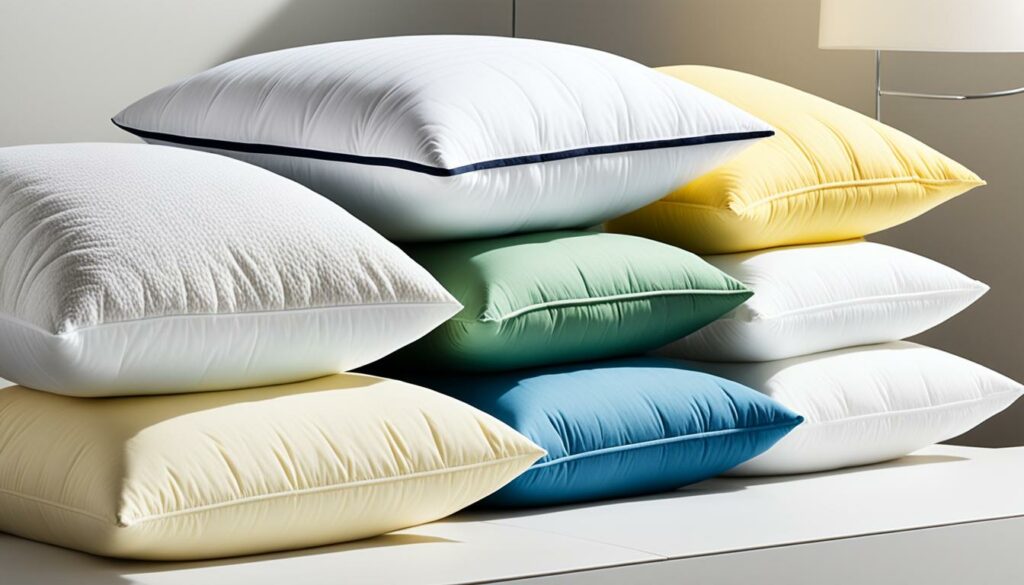
Regular Pillow Maintenance Tips
Keeping your pillows fresh and clean requires regular maintenance. Here are some essential tips to ensure the longevity and hygiene of your pillows:
1. Daily Fluffing
Fluffing your pillows daily helps remove dust and maintain their shape, providing optimum comfort and support. Simply give your pillows a gentle shake and fluff them by hand to restore their loftiness.
2. Outdoor Airing
On a sunny day, take advantage of the natural disinfecting properties of sunlight by airing your pillows outdoors. Place them on a clean surface, such as a clothesline, and allow them to bask in the sun. The UV rays can help eliminate odors and refresh your pillows.
3. Pillow Rotation
Rotate or flip your pillows every hour or two during outdoor airing to expose all surfaces to fresh air. This ensures that every part of your pillow receives proper ventilation and helps prevent the buildup of moisture and allergens.
4. Pillow Replacement
While regular maintenance can extend the lifespan of your pillows, it’s important to replace them every 1 to 2 years. Over time, pillows lose their shape, support, and hygiene, making it necessary to invest in new ones for a restful and healthy sleep experience.
Follow these simple pillow maintenance tips to keep your pillows in top condition, ensuring both comfort and cleanliness.
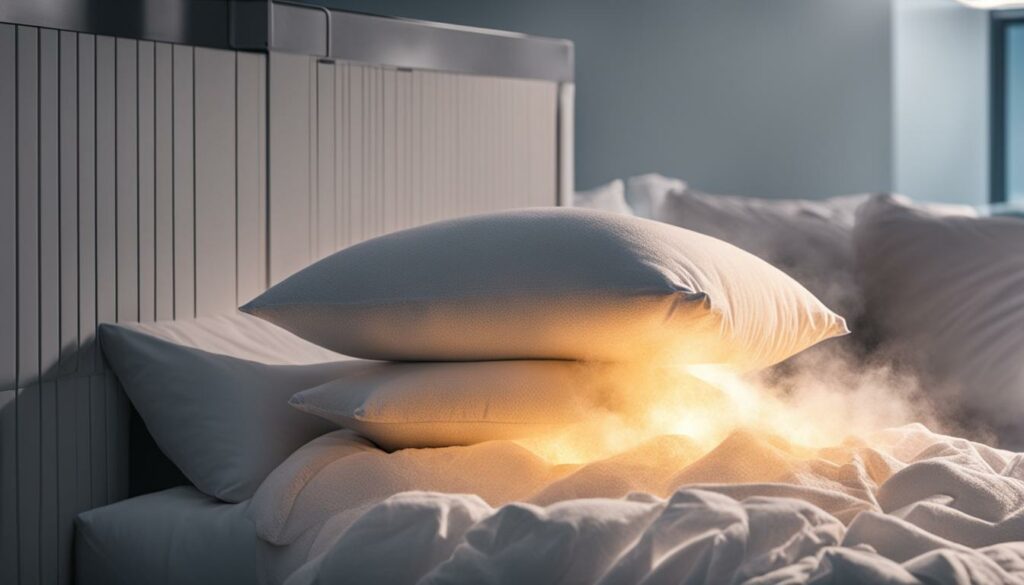
| Pillow Maintenance Tips | Pillow Fluffing | Outdoor Airing | Pillow Rotation | Pillow Replacement |
|---|---|---|---|---|
| Action | Fluff pillows daily to remove dust and maintain shape. | Take advantage of sunny days to air pillows outdoors and eliminate odors. | Rotate or flip pillows every hour or two during airing to expose all surfaces to fresh air. | Replace pillows every 1 to 2 years for optimal support and hygiene. |
| Benefits | – Removes dust and maintains pillow shape – Enhances comfort – Prolongs pillow lifespan |
– Natural disinfection from sunlight – Eliminates odors – Refreshes pillows |
– Prevents moisture buildup – Allows all surfaces to receive fresh air – Reduces allergens |
– Ensures sufficient support – Maintains hygiene and cleanliness – Promotes restful sleep |
Spot Cleaning and Dry Cleaning
While most pillows can be easily cleaned in a washing machine, there are certain types of pillows that require special care. For these pillows, spot cleaning or dry cleaning is recommended to ensure their longevity and maintain their quality.
Spot cleaning is a technique used to treat specific stains on the surface of a pillow without immersing the entire pillow in water. This method is ideal for delicate materials or pillows with sensitive fillings that may not withstand machine washing. To spot clean a pillow:
- Gently blot the stained area with a clean cloth or absorbent paper towel to remove any excess liquid or debris.
- Prepare a mixture of mild detergent and water. Use a small amount of detergent and mix it with water until it forms a soapy solution.
- Dip a clean cloth or sponge into the soapy solution and dab it onto the stained area. Be careful not to saturate the pillow.
- Gently rub the stained area in a circular motion to break up the stain. Avoid applying excessive pressure.
- After treating the stain, rinse the cloth or sponge with clean water and use it to blot the area. This helps remove any remaining detergent residue.
- Allow the pillow to air dry completely before using it again.
In some cases, pillows may be labeled as dry clean only. This means that they should be taken to a professional cleaner to avoid potential damage that may occur from water-based cleaning methods. Dry cleaning utilizes solvents to remove stains and dirt from the pillow’s surface. Professional pillow cleaning services have the expertise and specialized equipment to handle delicate materials and ensure thorough cleaning without compromising the pillow’s integrity.
When dealing with stains, it’s important to address them promptly to prevent them from setting or becoming more difficult to remove over time. Taking the appropriate cleaning measures for each type of pillow ensures their longevity and helps maintain their cleanliness and freshness.
Recommended Pillow Materials for Spot Cleaning
| Pillow Material | Spot Cleaning | Dry Cleaning |
|---|---|---|
| Down Feather | Yes | No |
| Polyester | Yes | No |
| Memory Foam | No | Yes |
| Buckwheat Hull | Yes | No |
Note: Always refer to the manufacturer’s care instructions for your specific pillow to ensure proper cleaning and maintenance.
Importance of Proper Drying and Storage
To maintain the cleanliness and longevity of your pillows, it is crucial to ensure they are completely dried after washing. Failure to do so can lead to the growth of mildew, which can cause unpleasant odors and potentially affect your health. Here are some essential tips on how to dry pillows properly and store them to prevent mildew and maintain their quality.
1. Checking for Moisture
After the washing and drying process, make sure to check your pillows for any remaining moisture. Even a small amount of dampness can create an ideal environment for mildew growth. Press your hands firmly against the pillows to detect any moisture inside. If you feel any dampness, continue the drying process until they are completely dry.
2. Hanging Pillows to Air Dry
One effective method for drying pillows is to hang them on a clothesline. This method works best in warm and sunny weather. Place your pillows in direct sunlight and ensure they are spread out and hung in such a way that allows air to circulate around them. This will help to remove any remaining moisture and prevent mildew formation. Remember to flip the pillows periodically to ensure both sides receive adequate airflow.
3. Storing Cool and Dry Pillows
Once your pillows are fully dry, it is important to store them properly to avoid any residual moisture. Make sure your pillows are cool to the touch before storing them. This ensures that there is no trapped heat that could create a damp environment. Store your pillows in a cool, dry place such as a clean closet or bedding storage container. Avoid storing them in areas prone to moisture, such as basements or bathrooms.
4. Additional Tips for Pillow Storage
To further prevent mildew growth during storage, consider these additional tips:
- Use breathable pillow covers or pillowcases to allow air circulation
- Avoid packing pillows too tightly, as this can trap moisture
- Avoid storing pillows in plastic bags, as they can trap moisture and promote mildew growth
| Method | Advantages | Disadvantages |
|---|---|---|
| Hanging Pillows to Air Dry | – Removes moisture effectively – Freshens the pillows – Natural method |
– Weather-dependent – Requires outdoor space |
| Air-Drying on a Flat Surface | – Even drying – Suitable for pillows with delicate materials |
– Takes longer time to dry – Requires a flat surface |
| Using a Dryer | – Quicker drying process – Convenient – Can fluff the pillows |
– Requires monitoring and low heat setting – May cause damage if not done correctly |
By following these tips, you can ensure that your pillows are thoroughly dried and properly stored to prevent the growth of mildew. Taking these extra precautions will help maintain the cleanliness, freshness, and longevity of your pillows, ensuring a comfortable and healthy sleep environment.
How Long Do Pillows Last?
Despite regular cleaning and maintenance, pillows have a lifespan and should be replaced periodically. Most pillows should be replaced every 1 to 2 years. Higher-quality pillows may last up to 5 years. Signs that indicate the need for pillow replacement include reduced support, lumpiness, discomfort, and unremovable odors or stains.
Final Thoughts
Proper pillow care is crucial for maintaining hygiene and ensuring a restful night’s sleep. By regularly washing and drying your pillows, you can effectively eliminate germs and keep them fresh. It’s also important to follow specific care instructions based on the type of pillow filling to prevent any damage.
However, it’s essential to remember that even with proper care, pillows have a lifespan. Regular replacement is necessary to maintain optimal support and hygiene. Over time, pillows can lose their shape, become lumpy, and develop unremovable odors or stains, indicating the need for a new pillow.
So, make it a priority to incorporate pillow care into your cleaning routine. By doing so, you’ll not only create a clean sleeping environment but also extend the life of your pillows, ensuring a comfortable and healthy sleep experience.
FAQ
Does putting pillows in the dryer kill germs?
Yes, putting pillows in the dryer can effectively kill germs by removing moisture and preventing the growth of bacteria, mold, and mildew.
Why is pillow cleaning important?
Pillow cleaning is important to maintain good hygiene and eliminate germs that can accumulate on pillow covers and seep into the filling material. It also helps prevent unpleasant odors and maintains pillow support.
How do you wash pillows?
To wash pillows, remove any covers or pillowcases and check the manufacturer’s instructions. Most down and synthetic pillows can be machine-washed on low heat with a fragrance-free laundry detergent. Spot-clean any stains before running the wash cycle.
How do you dry pillows in the dryer?
To dry pillows in the dryer, use a low heat setting and check the pillows every 20 to 30 minutes for even drying. Adding dryer balls or a tennis ball in a sock can aid in fluffing the pillows. Complete drying is crucial to maintain pillow hygiene and eliminate any remaining moisture.
What are some alternative drying methods for pillows?
Alternative drying methods for pillows include air-drying them by hanging on a clothesline and sun-drying them, which acts as a natural disinfectant. Ensure pillows are as flat as possible during sun-drying to kill bacteria and potential viruses present on the surfaces.
How do you care for different pillow fillings?
Different pillow fillings require specific care. Down feather pillows can be machine-washed with cool water and dried on a no-heat air-dry setting. Polyester pillows should be washed with less detergent on the gentle cycle with warm water. Memory foam and latex pillows are best hand-washed. Buckwheat hull pillows require sun-drying to eliminate odors.
What are some regular pillow maintenance tips?
Regular pillow maintenance includes daily fluffing to remove dust and maintain shape, outdoor airing on a sunny day to eliminate odors, and rotating or flipping pillows every hour or two during airing for freshening all surfaces. Pillows should be replaced every 1 to 2 years to ensure sufficient support and hygiene.
How do you spot clean and dry clean pillows?
Spot cleaning involves treating specific stains on the surface without immersing the entire pillow. Delicate pillows that cannot withstand machine washing should be hand-washed. Pillows labeled as dry clean only should be taken to a professional cleaner to avoid potential water damage.
Why is proper drying and storage important for pillows?
Properly drying pillows is important to prevent the growth of mildew. After washing and drying, pillows should be checked for any moisture inside. Pillows should only be stored when cool and fully dry to avoid lingering moisture and potential mildew development.
How long do pillows last?
Most pillows should be replaced every 1 to 2 years. Higher-quality pillows may last up to 5 years. Signs indicating the need for replacement include reduced support, lumpiness, discomfort, and unremovable odors or stains.
Any final thoughts on pillow care and hygiene?
Proper pillow care, including regular washing, drying, and maintenance, is crucial for maintaining hygiene and ensuring a good night’s sleep. Following specific care instructions for different pillow fillings is important. Ultimately, regular pillow replacement is necessary to maintain optimal support and hygiene.
Eric Christie stands as a luminary in the bedding industry, with a career spanning nearly four decades since the early 1980s. His journey through the world of bedding has seen him wear many hats – a manufacturer, designer, and retailer, showcasing his versatility and expertise in Read more...


